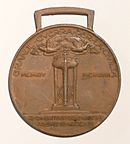Allied Victory Medal (Italy) facts for kids
Quick facts for kids Allied Victory MedalMedaglia interalleata della vittoria |
|
|---|---|

Obverse and reverse of the medal
|
|
| Presented by | |
The Allied Victory Medal (in Italian, Medaglia interalleata della vittoria) was a special award given to Italian soldiers. It was created after World War I to honor those who served. This medal was Italy's version of a common "Victory Medal" given by many Allied countries. It celebrated their shared success in the war.
What is the Allied Victory Medal?
The Allied Victory Medal was a way to recognize the brave Italian soldiers. It honored their service during the "Great War," which we now call World War I. The medal was officially created on December 16, 1920. This happened through a special rule called royal decree number 1918.
Who Received This Special Medal?
This medal was given to Italian soldiers and officers who had shown great effort during the war. To get the medal, they usually needed to have received a special "war efforts" award earlier. Another way to qualify was to have served for at least four months. This service had to be in an area controlled by the armed forces. It also included those who were called up for duty and worked directly with the fighting army. About 2 million of these medals were awarded in total.
How Was the Medal Designed?
The design of the Allied Victory Medal was chosen through a public contest. Many artists submitted their ideas. The winning design came from an artist named Gaetano Orsolini. His design showed "Victory on a triumphal chariot." This chariot was pulled by four strong lions. Victory held the "torch of liberty," symbolizing freedom and success.

